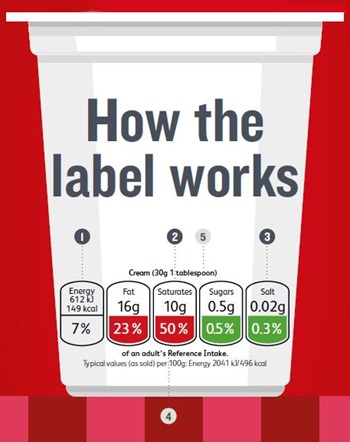Food labelling
Food labels contain so much information, it’s often difficult to know what you should be looking for and what it all means. But if you want to improve your diet and make healthy choices, it's important to get into the habit of checking the label.
What should I look for on the label?
Most products have nutritional information on the label. Some products also have colour coding on the front, which tells you if the food has high (red), medium (amber) or low (green) amounts of fat, saturated fat, sugars and salt.
The more green(s) on the label, the healthier the choice.
 How the label works
How the label works
Look for five key points on the label:
1. Energy
The terms ‘kJ’ and ‘kcal’ (calories) tell you how much energy is in a product. Women need an average of 2,000 kcal a day and men need 2,500 kcal on average.
2. Saturates
Saturates is another word for saturated fat. This section tells you about the amount of saturated fat in the product.
3. Salt
Most adults eat more salt than the recommended maximum of 6g a day, increasing their risk of high blood pressure. You may see ‘sodium' listed rather than salt. To convert sodium into salt, multiply the amount on the label by 2.5.
4. Reference Intake
Reference intakes (RI) are useful guidelines on the amount of energy and nutrients you need for a healthy, balanced diet each day. The %RI tells you how much of your daily healthy maximum is in the portion of the product.
The %RI for an adult is based on the following values:
- Kcal - 2000
- Fat - 70g
- Saturates - 20g
- Sugars - 90g*
- Salt - 6g
*This figure is for total sugars, which include free sugars, plus sugars from milk and fruit. Adults should limit free sugars to no more than 30g a day.
5. Portion size
The portion size on the pack is the manufacturer's recommendation for one portion of the product. The %RI is worked out based on this portion size. Some packs also show the amount of each nutrient in 100g of the product. This will be given in grams or millilitres.
A manufacturer's idea of a portion size might be smaller than yours. Even if a product looks healthy, if you have more than this portion amount you may end up consuming more calories, saturated fat or salt than you realise.
Top tips
- Reduced and low-fat are not the same thing. Low-fat means a product has 3g or less fat per 100g, while reduced fat means a product is 25 per cent lower in fat than the standard product. These foods are often very high in fat to start with, for example mayonnaise, crisps and cheese. You still need to limit how much you eat as the reduced fat version is likely to still be high in fat.
- Sugar is not always listed in the ingredients as ‘sugar'. Look out for the following terms; sucrose, glucose, fructose, maltose, honey, palm sugar, hydrolysed starch, syrup and invert sugar. Remember, the higher up on the ingredients list sugar is, the more added sugar is in the product.
Heart Helpline & other support:
- Speak to our cardiac nurses by phone, callback, email or online chat on Heart Helpline (Monday to Friday, 9am to 5pm).
- Contact us to talk to our customer care advisors, find your local BHF shop and for any comments, compliments and complaints you may have.
- Download our guide on food labels or our Eat Better booklet.
- Find out more about what we're doing to bring about change that helps people make healthy choices using food labelling.
- Sign up to our Heart Matters magazine for online information packed with health and lifestyle advice.

You can trust our health information
We've followed an eight-step process to make sure this content is reliable, accurate and trustworthy.
Learn how we make our health content.Donate today



